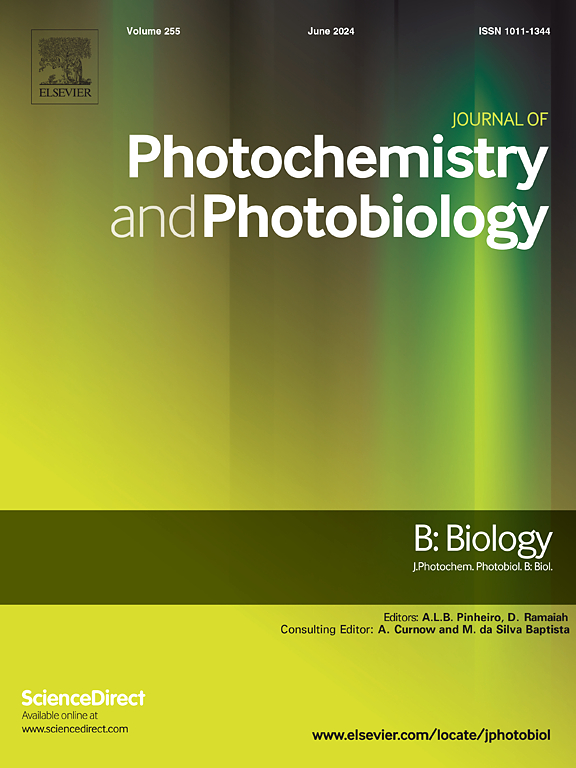Maintaining KEAP1 levels in retinal pigment epithelial cells preserves their viability during prolonged exposure to artificial blue light
IF 3.9
2区 生物学
Q2 BIOCHEMISTRY & MOLECULAR BIOLOGY
Journal of photochemistry and photobiology. B, Biology
Pub Date : 2024-09-24
DOI:10.1016/j.jphotobiol.2024.113037
引用次数: 0
Abstract
Exposure to artificial blue light, one of the most energetic forms of visible light, can increase oxidative stress in retinal cells, potentially enhancing the risk of macular degeneration. Retinal pigment epithelial (RPE) cells play a crucial role in this process; the loss of RPE cells is the primary pathway through which retinal degeneration occurs. In RPE cells, Kelch-like ECH-associated protein 1 (KEAP1) is located in both the nucleus and cytosol, where it binds to nuclear factor erythroid 2-related factor 2 (NRF2) and p62 (sequestosome-1), respectively. Blue light exposure activates the NRF2-heme oxygenase 1 (HMOX1) axis through both canonical and noncanonical p62 pathways thereby reducing oxidative damage, and initiates autophagy, which helps remove damaged proteins. These protective responses may support the survival of RPE cells. However, extended exposure to blue light drastically decreases the viability of RPE cells. This exposure diminishes the ability of KEAP1 to bind to p62 and reduces the level of KEAP1. Inhibition of autophagy does not prevent KEAP1 degradation, the NRF2-HMOX1 axis, or blue-light-induced cytotoxicity. However, proteasome inhibitor along with a transient increase in the amount of KEAP1 in RPE cells, partially restores the p62-KEAP1 complex and reduces blue-light-induced cytotoxicity. In vivo studies confirmed the downregulation of KEAP1 in damaged RPE cells. Mice subjected to periodic blue light exposure exhibited significant atrophy in the outer retina, particularly in the peripheral areas. Additionally, there was a significant decrease in c-wave electroretinography and pupillary light reflex, indicating functional impairments in both visual and nonvisual physiological processes. These data underscore the essential role of KEAP1 in managing oxidative defense and autophagy pathways triggered by blue light exposure in RPE cells.
维持视网膜色素上皮细胞中 KEAP1 的水平可在长时间暴露于人工蓝光时保持其活力
人工蓝光是能量最高的可见光之一,暴露于蓝光中会增加视网膜细胞的氧化应激,从而可能增加黄斑变性的风险。视网膜色素上皮(RPE)细胞在这一过程中起着至关重要的作用;RPE 细胞的丧失是视网膜变性的主要途径。在 RPE 细胞中,Kelch 样 ECH 相关蛋白 1(KEAP1)位于细胞核和细胞质中,分别与核因子红细胞 2 相关因子 2(NRF2)和 p62(sequestosome-1)结合。蓝光照射会通过规范和非规范 p62 途径激活 NRF2-血红素加氧酶 1(HMOX1)轴,从而减少氧化损伤,并启动有助于清除受损蛋白质的自噬作用。这些保护性反应可能有助于 RPE 细胞的存活。然而,长时间暴露在蓝光下会大大降低 RPE 细胞的存活率。这种暴露会削弱 KEAP1 与 p62 结合的能力,并降低 KEAP1 的水平。抑制自噬并不能阻止 KEAP1 降解、NRF2-HMOX1 轴或蓝光诱导的细胞毒性。然而,蛋白酶体抑制剂以及 RPE 细胞中 KEAP1 数量的短暂增加,部分恢复了 p62-KEAP1 复合物,降低了蓝光诱导的细胞毒性。体内研究证实了 KEAP1 在受损的 RPE 细胞中的下调作用。接受周期性蓝光照射的小鼠外层视网膜表现出明显的萎缩,尤其是在周边区域。此外,c 波视网膜电图和瞳孔光反射也显著下降,这表明视觉和非视觉生理过程都出现了功能性损伤。这些数据强调了 KEAP1 在管理 RPE 细胞因蓝光照射而引发的氧化防御和自噬途径中的重要作用。
本文章由计算机程序翻译,如有差异,请以英文原文为准。
求助全文
约1分钟内获得全文
求助全文
来源期刊
CiteScore
12.10
自引率
1.90%
发文量
161
审稿时长
37 days
期刊介绍:
The Journal of Photochemistry and Photobiology B: Biology provides a forum for the publication of papers relating to the various aspects of photobiology, as well as a means for communication in this multidisciplinary field.
The scope includes:
- Bioluminescence
- Chronobiology
- DNA repair
- Environmental photobiology
- Nanotechnology in photobiology
- Photocarcinogenesis
- Photochemistry of biomolecules
- Photodynamic therapy
- Photomedicine
- Photomorphogenesis
- Photomovement
- Photoreception
- Photosensitization
- Photosynthesis
- Phototechnology
- Spectroscopy of biological systems
- UV and visible radiation effects and vision.

 求助内容:
求助内容: 应助结果提醒方式:
应助结果提醒方式:


